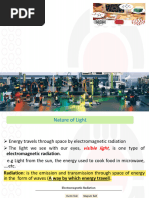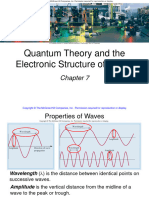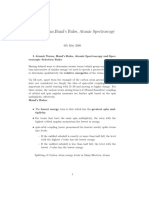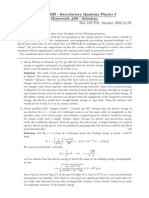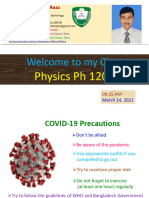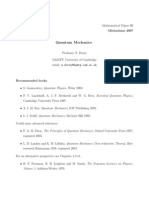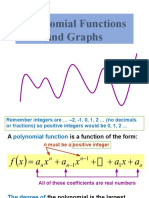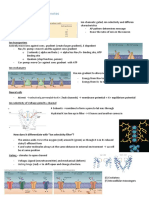Chemistry 1A Spectroscopy.: Prof. Mike Ashfold (S305) (Mike - Ashfold@bris - Ac.uk)
Uploaded by
Abd El-Fattah Mohamed OufChemistry 1A Spectroscopy.: Prof. Mike Ashfold (S305) (Mike - Ashfold@bris - Ac.uk)
Uploaded by
Abd El-Fattah Mohamed Ouf1
CHEMISTRY 1A
Spectroscopy.
Prof. Mike Ashfold (S305)
(mike.ashfold@bris.ac.uk)
Aim of the Course:
This course begins with a brief review of
electromagnetic radiation, and introduces
the Born-Oppenheimer separation of the various
contributions to the total energy of a molecule.
It then introduces
rotational (microwave) spectroscopy,
vibrational (infrared) spectroscopy, and
nuclear magnetic resonance spectroscopy
and demonstrates the use of each in determining
details of molecular structure.
2
CHEMISTRY IA
SPECTROSCOPY
Prof. Mike Ashfold (S305)
mike.ashfold@bris.ac.uk
http://www.chm.bris.ac.uk/pt/laser/ashfold/teaching.htm
Recommended texts:
P.W. Atkins and P. de Julia,
Atkins Physical Chemistry (7
th
edn)
P.W. Atkins, Elements of Physical Chemistry
C.N. Banwell and E. McCash,
Fundamentals of Molecular Spectroscopy (4
th
edn)
SPECTROSCOPY relies on the
interaction between matter
(our atom or molecule of interest)
and electromagnetic radiation
Absorption, emission and scattering
3
From Quantum Ideas course (AJOE) we
know that radiation may be pictured as a
wave
-wavelength, diffraction, interference effects
or as a photon
c = (1.1)
speed of light frequency wavelength
in vacuum
c = 2.9979 x 10
8
m s
-1
Units of frequency: s
-1
or Hz.
wavelength: m
Wavenumber (cm
-1
) = 1/(cm)
Energy (units: J) of a photon of frequency,
E = h (1.2)
Planck constant, h = 6.626 x 10
-34
J s
4
Electromagnetic spectrum
(and classification of its regions)
4. 34.85 .25.7 6.47.1 x1 0 Hz 14 70 0 6205 8 0530 470420 n m RedOrang YellowGreen BlueViolet Radi o frequen cy Mi crowave Fari nfra redNeari nfrared U l t ra vi o l etV acuum u l travi ol etXray srays Vis Freq u ency l og( /Hz) Wav e l engths 3km 3m30 cm 3 mm 0.03mm 3 00 nm3n m 3p Nucl ea r magne ti c resona n ce spectr o scopy Rotati o nal spectro s copy Vi brati on a l spectros c opyEl e ctroni c sp e ctrosco py
Atoms and molecules can only exist in certain
discrete energy states. Transitions between
these states will only occur when a photon of the
appropriate frequency is absorbed or emitted.
5
Transitions must satisfy the Bohr-Einstein relation
E
2
E
1
absorption
emission
E = E
2
E
1
= h (1.3)
e.g. Na D-line emission (responsible for
orange-yellow glow of street lights).
State 1 has configuration 1s
2
2s
2
2p
6
3s
1
State 2 has configuration 1s
2
2s
2
2p
6
3p
1
E = 3.37x10
-19
J per atom (203 kJ mole
-1
)
From eq. (1.3): = E/h = 5.09 x 10
14
s
-1
Corresponding wavelength, = = 589.3 nm
c
6
BORN-OPPENHEIMER SEPARATION
Electrons are much lighter than nuclei, and
therefore move much faster.
The electrons thus adjust instantaneously to
any changes in the nuclear geometry.
Thus we can treat electronic and nuclear
contributions to the total energy of a
molecule additively.
The total energy is normally treated as a
sum of parts, i.e.
E
total
=
E
electronic
+ E
vibrational
+ E
rotational
+ E
translational
(1.4)
The underlined contributions are quantised,
whereas translational energy levels are treated
as a continuum.
7
Relative amounts of energy involved in
different state changes:
E(change of electronic state) is
~ 10 -10
2
E(change of vibrational state),
and
E(change of vibrational state) is
~ 10
3
E(change of rotational state)
Transitions from one rotational state to another
are observed in the RADIO FREQUENCY and
MICROWAVE region.
Transitions involving a change of vibrational
state appear in the INFRARED spectral region
Electronic transitions are generally observed via
VISIBLE or ULTRAVIOLET spectroscopy.
8
Ground state
1st excited
electronic state
2nd excited
electronic state
v=0
v=1
v=2
v=3
v=0
v=1
v=2
v=3
v=0
v=1
v=2
v=3
rotational levels
vibrational
levels
E
n
e
r
g
y
Energy levels of a diatomic molecule
9
MEASURING A SPECTRUM
- generally measured in absorption
transmitted light intensity
I
trans
I
0
Length of sample, L
Concentration, c L 0
incident light intensity
cL
= e I I
0
trans
Beer-Lambert law:
cL -
10 I I
0
trans
=
(1.5)
or, in base 10:
[ / (ln 10)] is the molar absorption coefficient
I
0
exp(-cL)
To record a spectrum:
Measure I
trans
,
or I
absorbed
= (I
0
I
trans
),
as a function of wavelength
(or frequency).
I
trans
L
10
PURE ROTATION (OR MICROWAVE)
SPECTROSCOPY
Aim:
To obtain an expression for the allowed
rotational energy levels of a diatomic molecule.
Start from the classical expression for the
kinetic energy (KE) of a rotating body:
KE = I
2
(2.1)
Moment of inertia, I = R
2
, where is the reduced
mass.
For the case of a diatomic molecule consisting of
two atoms of mass m
1
and m
2
,
2 1
2 1
m m
m m
+
=
R is the distance between the two masses - the
internuclear separation. I thus has units of kg m
2
.
is the angular frequency units of rad s
-1
.
It is related to , the frequency in s
-1
, by = 2.
11
The associated angular momentum P is given by
P = I (2.2)
P is a vector. It has
magnitude and direction
(perpendicular to the
plane of rotation).
P
Combining (2.1) and (2.2):
KE = (2.3)
Is P
2
a continuous variable?
Not in the microscopic world of atoms and molecules.
P
I 2
2
Angular momentum is quantised.
For a diatomic molecule:
P = (2.4)
h ) J ( J 1 +
magnitude of rotational
angular momentum
rotational quantum number,
J = 0,1,2,3, .
h is h/2 (i.e. Planck constant divided by 2)
P can only occur in certain multiples of h
12
Substituting (2.4) into (2.3):
Energy, E = ) J ( J
1
8
2
2
+
I
h
E = hBJ(J+1) (2.5)
This kinetic energy is the total rotational
energy (i.e. there is no potential energy
contribution to the rotational energy)
B = is known as the rotational constant.
I
h
2
8
The SI units of B are s
-1
but it is often quoted in cm
-1
.
[Recall B(cm
-1
) = B(s
-1
) / c(cm s
-1
)]
Since J in (2.5) can only take integer values,
E
rotation
must be quantised.
13
J E
rot
5 30hB
4 20hB
3 12hB
2 6hB
1 2hB
0 0
E = 10hB
Energy
E = 8hB
E = 6hB
E = 4hB
E = 2hB
allowed rotational energy levels
Transition frequencies are given by the Bohr condition:
= E/h = 2B(J + 1) (2.6)
where J is the quantum number of the lower rotational
level.
14
SELECTION RULES:
Two conditions must be satisfied in order that a
pure rotation transition will be observed:
The molecule must have a permanent
dipole moment,
+ +
e.g. HCl, CO, but not H
2
, N
2
or O
2
The rotational quantum number must change
by 1
J = +1, i.e. J J +1 absorption
J = 1, i.e. J J 1 emission
Thus a microwave absorption spectrum has the
general form:
0 2B 4B 6B 8B 10B 12B 14B
frequency,
Absn.
J =1 2 3 4
J =0 1 2 3
etc
15
An electric dipole consists of two charges,
separated by a distance, R.
A dipole is represented by a vector, , that
points from the negative to the positive charge.
(Perhaps confusingly, electric dipoles are often
represented by an arrow
added to the Lewis structure, with the + marking
the positive end).
The magnitude of the vector = qR, and is
called the electric dipole moment.
The SI units of are C m, but dipole moments
are usually quoted in Debye.
(1 D = 3.336 10
-30
C m).
Dipole moments in molecules arise as a
result of the different partial charges on atoms
linked by a polar bond.
16
CENTRIFUGAL DISTORTION
Real molecules are not rigid rotors.
As a molecule rotates faster it has:
higher angular momentum, and thus
is subjected to centrifugal distortion.
Its bond length increases, so
its moment of inertia increases (since I = R
2
), and
its effective rotational constant must therefore
decline, since B is inversely related to I.
Thus higher J J + 1 transitions in a microwave
spectrum will become progressively more
closely spaced.
To accommodate such centrifugal distortion effects,
the rigid rotor expression for the energy of a rotational
level (eq. 2.5) is modified to:
E = hBJ(J+1) hDJ
2
(J+1)
2
(2.7)
The J J + 1 transition frequency (2.6) becomes:
= E/h = 2B(J + 1) 4D(J + 1)
3
(2.8)
D is the centrifugal distortion constant;
It is a small correction (D ~ 10
-5
B), so its effect only
becomes really noticeable at high J.
17
Microwave spectroscopy provides one of the
most accurate methods for determining bond
lengths and bond angles in small molecules.
Consider the simple case of a diatomic
molecule, AB:
If we measure the frequency of several
rotational lines in its microwave spectrum
then, from eqs (2.7) and (2.8), we can
determine B and D.
Then, since B= , [eq. (2.5)], we can
determine the moment of inertia, I.
h
2
I 8
Knowing I, our task is now to obtain the
internuclear separation, R.
18
A B
centre of mass
mass m
1
m
2
R
1
R
2
R
Moment of inertia, I = m
i
R
i
2
(2.9)
(for diatomic) = m
1
R
1
2
+ m
2
R
2
2
(i)
We also know that: R = R
1
+ R
2
(ii)
And, from principle of moments:
m
1
R
1
= m
2
R
2
(iii)
Rearranging (i) (iii)
I = R
2
= R
2
(2.10)
i
2 1
2 1
m m
m m
+
19
=
2 1
2 1
m m
m m
+
Reduced mass,
2 1
1 1 1
m m
+ =
or
Thus, knowing B I, and hence R
e.g. for CO:
B = 1.92118 cm
-1
= 5.7596 10
10
s
-1
I
CO
= 1.457 10
-48
kg m
2
R
CO
= 1.131 10
-10
m (0.1131 nm)
This is the average internuclear separation
of the two nuclei in the lowest energy state
of a CO molecule.
20
Two factors determine the relative intensities of
lines appearing in a microwave spectrum.
- Intensity (permanent dipole moment)
2
number of molecules (N
J
) in the
rotational level (with quantum
number J) that absorb at the
particular excitation frequency.
N
J
g
J
exp{E
rot
/k
B
T} (2.11)
degeneracy
Boltzmann factor
k
B
= 1.38 10
-23
J K
-1
(Boltzmann constant)
T = temperature in K.
Eq. (2.11) is one particular form of the
Boltzmann distribution law:
] T / exp[
g
g
N
N
B
lower
upper
state lower
state upper
k E =
(2.12)
21
More on the degeneracy term, g
J
:
Each rotational level with quantum number
J actually consists of (2J+1) different states
all of the same energy.
This degeneracy can be lifted (i.e. broken)
by the application of a magnetic or electric
field
Each of the (2J+1) states is characterised
by a quantum number M.
M can take values:
J, J1, J2, ..0, J. (2.13)
e.g. a molecule in a state with rotational quantum
number J = 1 can have M = 1, 0 or 1.
] T / exp[
J
N
N
B rot
J
k E
+
=
1
1 2
0
Thus:
22
e.g. for BrF molecule at 300 K
0
5
10
15
20
25
0 10 20 30 40 50 60
J
Population relative to the ground state
Q: Where have you encountered a
comparable degeneracy term?
A: In discussing atomic orbitals
Orbital type s p d f
= 0 1 2 3
Degeneracy 1 3 5 7
l
23
Real microwave spectrum thus has the form:
J =1 2 3 4
J =0 1 2 3
etc
absorption
0 2B 4B 6B 8B 10B 12B 14B
frequency,
IF KEEN:
For a rigid rotor:
] T / ) J ( J B exp[ ) J ( N
B J
k h 1 1 2 + +
To find the most populated J state, differentiate
with respect to J and solve to find J value for
which
0 =
dJ
dN
J
2
1
2
B
T
B
h
k
J
most populated
=
(2.14)
24
21
st
century applications of pure
rotational spectroscopy:
Astronomy and astrochemistry
Radio wave spectrum of Sagittarius B2 showing
rotational transitions in an interstellar cloud.
25
VIBRATIONAL (INFRARED) SPECTROSCOPY
The frequencies of molecular vibrations fall in
the range ~10
13
10
14
s
-1
(~300 4000 cm
-1
).
e.g. for CO, successive vibrational energy levels
are separated by ~2170 cm
-1
(c.f. rotational energy level spacings of ~10 cm
-1
).
Picture molecules as two (or more) nuclei held
together by non-totally rigid bonds
(i.e. like springs).
A B
R
e
equilibrium (or mean) separation
The bond length is constantly fluctuating about
R
e
as a result of zero-point vibrational motion.
26
The restoring force F (in Newtons) exerted by
a spring is proportional to its displacement x
(in metres) from the equilibrium position, i.e.
the bond is pictured as a spring, and obeys
Hookes law
F = k(R R
e
) = kx (3.1)
implies that the force
acts so as to drive the
system back towards R
e
displacement from
equilibrium
Force constant / N m
-1
x
Pull
Restoring force = F
27
Illustrative values of k:
CO: 1900 N m
-1
HCl: 516 N m
-1
HI: 314 N m
-1
i.e. stiffer bonds have larger k.
Concentrate on a vibrating diatomic molecule.
The potential energy, V, is given by
x V F d / d =
= x F V d -
Recalling eq. (3.1)
V = kx
2
= k (R R
e
)
2
(3.2)
This is known as a harmonic oscillator potential;
(V has the shape of a parabola).
28
The amplitude of the vibrational motion
increases with total energy, with each atom
moving relative to the centre of mass.
A
centre of mass
A B B
If we solve the Schrodinger equation with eq.
(3.2) as the potential energy term we obtain
the vibrational wavefunctions and the following
expression for the allowed vibrational energy
levels of a harmonic oscillator:
E
v
= (v + )h (3.3)
vibrational quantum number,
v = 0, 1, 2, ..
where =
k
2
1
(3.4)
force constant
vibrational
frequency
reduced mass
29
internuclear distance /nm
0.085 0.090 0.095 0.100
E
V
I
B
/
c
m
-
1
0
4000
8000
12000
16000
20000
24000
HF simulation
5
4
3
2
1
v = 0
Note:
The lowest vibrational energy level, with
vibrational quantum number, v = 0, has
E
v=0
= h 0
A molecule cannot have zero vibrational energy
consistent with the uncertainty principle. This
energy is called the zero-point energy.
30
SELECTION RULES:
Two conditions must be satisfied in order
that a vibrational transition will be observed:
d
0
R d
i.e. the vibration must cause a
change in the dipole moment
Thus, HCl and CO and infrared (IR) active,
but N
2
, O
2
and H
2
are not.
v = 1.
The transition frequency thus occurs at:
E = E
v+1
E
v
= ((v + 1) +)h (v +)h
= h
Thus we might predict the following appearance
for an IR absorption spectrum
absorption
frequency
v = 1 v = 0
v = 2 v = 1, etc
31
IR spectra are often recorded in wavenumber units:
=
/c
is typically in the range 600-4000 cm
-1
where
This model is too simplistic.
Real molecules are not truly harmonic
oscillators.
At high enough levels of vibrational excitation
the bond must break two atoms.
The true potential function is anharmonic.
Internuclear distance /nm
0.0 0.2 0.4 0.6 0.8 1.0
E
n
e
r
g
y
/
k
J
m
o
l
-
1
0.0
200.0
400.0
600.0
800.0
1000.0
5
1
0
2
3
4
1
0
2
3
4
v =
Dissociation
Energy
32
Dissociation energies:
D
e
measured relative to potential minimum
D
0
measured relative to energy of v = 0
level.
The vibrational energy levels are more
closely spaced at higher vibrational energies
and merge to form a continuum at the
dissociation limit.
In the case of a Morse potential:
E
v
= (v + )h (v + )
2
hx (3.5)
anharmonicity constant
Anharmonicity relaxes the selection rules,
allowing v = 1, 2, 3, etc
fundamental band
overtone transitions
(These exhibit progressively
weaker intensities).
33
The overtone frequencies are no longer
exact multiples of the v = 1 v = 0
fundamental.
The frequencies of the v = 2 v = 1,
v = 3 v = 2 etc transitions are red-shifted
relative to the v = 1 v = 0 fundamental.
E = E
v+1
E
v
= h 2(v +1)hx
absorption
v = 1 v = 0
2 1
3 2
frequency
IR transition intensities are determined by
(i) The magnitude of
R d
d
(ii) The relative populations of the various
vibrational levels,
N
v
exp
(
T
B
v
k
E
34
VIBRATIONS OF POLYATOMIC MOLECULES
An N atom molecule has a total of 3N degrees
of freedom.
3 correspond to translation of the centre of mass.
Thus 3N3 correspond to vibrations and rotations.
How these are sub-divided depends on the shape
of the molecule.
A LINEAR molecule has 2 rotational degrees
of freedom; it has no rotation about the bond
axis, like a diatomic.
Linear molecules thus have 3N5 vibrational
degrees of freedom (modes).
A NON-LINEAR molecule has non-zero moments
of inertia about three orthogonal axes (a, b and c).
Non-linear molecules thus have 3 rotational
degrees of freedom and thus 3N6 vibrational
modes.
35
Vibrations are referred to as normal modes.
A normal mode is a mode of vibration in
which all of the atoms move in phase and
with the same frequency, while the centre
of mass remains stationary.
e.g. H
2
O:
H
O
H
symmetric stretch
(
1
= 3652 cm
-1
)
Parallel band
O
bend
(
2
= 1595 cm
-1
)
Parallel band
H
H
O
asymmetric stretch
(
3
= 3756 cm
-1
)
Perpendicular band
H
H
symmetry axis
36
Parallel and perpendicular descriptors refer to
the direction of the change of dipole moment
(i.e. d/dR or, more generally, d/dq ) relative
to the symmetry axis.
Stretching vibrations lie at higher wavenumber
(frequency) than bending modes.
Recall eq. (3.4);
k
It is easier for a molecule to bend than to stretch
All three modes in H
2
O have d/dq 0, and
will thus be infrared active.
Now consider CO
2
, a linear molecule
______________
2
and
3
are IR active.
2
is a perpendicular band the change in
accompanying this vibration is perpendicular
to the linear axis.
3
is a parallel band.
1
is IR inactive (like a homonuclear diatomic).
37
Normal mode vibrations in CO
2
d/dq
O
= 0
O
C
1
, symmetric stretch
C
O
O
0
O
O
C
2
, bend (doubly degenerate)
C
O
O
0
3
, asymmetric stretch
38
1
can be observed by Raman spectroscopy
see Level 3 notes.
This illustrates the Rule of Mutual Exclusion:
In centrosymmetric molecules like CO
2
, C
6
H
6
etc, modes are either IR or Raman active,
not both.
(In molecules with no centre of symmetry some
modes may be both IR and Raman active,
others may be inactive to both spectroscopies).
Each IR active vibrational mode will show
v = 1 transitions, plus
weak overtone (i.e. v = 2, 3, etc) and
combination (i.e. v
i
= 1, v
j
= 1) transitions
Each vibrational band will show rotational fine
structure see later.
39
ANALYSIS BY IR SPECTROSCOPY
N atom polyatomic molecule has 3N-6
(3N-5 if linear) vibrational modes.
Many of these modes may be IR active
IR spectra can be very complex.
Some of the modes involve similar motions
of most or all of the constituent atoms, but in
others the movements may be very much
localised in one part of the molecule, e.g.
Cl
H C
Cl
Cl
40
This stretching vibration involves motion of
a light H atom against an (almost stationary)
heavy blob. The exact nature of the blob is
largely irrelevant.
characteristic group frequencies.
Examples:
Group Approximate wavenumber / cm
-1
OH 3600
NH
2
3400
CH 3300
=CH
2
3030
CH
3
2970 (asym. str.)
2870 (sym. str.)
SH 2580
CN 2220
C =O 1750-1600
C=C 1650, etc
e.g. CH stretching frequency is much the same in
all molecules containing a CH bond.
41
INFRARED SPECTRUM OF PROPANONE
Wavenumber / cm
-1
(CH
3
)
2
CO
Characteristic group frequencies appear at
wavenumbers >1500 cm
-1
Strong absorption dip at ~1715 cm
-1
reveals
presence of C=O group
Region below 1500 cm
-1
referred to as the
fingerprint region normally hard to interpret
but very characteristic of the molecule under
investigation.
42
VIBRATION-ROTATION SPECTRA
Real molecules are vibrating and rotating,
at the same time.
BUT, recalling typical vibrational (10
14
s
-1
)
and rotational (10
12
s
-1
) frequencies, it follows
that a typical molecule will execute ~100
vibrations per rotation.
Hence the fact that we can derive very
accurate equilibrium bond lengths from
microwave spectroscopy and the energy
separation implied by eq. (1.4).
If we focus on a stationary linear molecule,
in its ground electronic state
E
total
= E
vibration
+ E
rotation
= (v + )h + hBJ(J+1) (3.6)
neglecting
anharmonicity
neglecting
centrifugal distortion
43
P, R (and Q) branches
Focus on absorption spectra.
These are dominated by v = +1 transitions.
The accompanying rotational fine structure varies:
J = 1 transitions occur in a parallel band,
whereas perpendicular bands show lines
associated with J = 0 and 1 transitions.
Convention:
Upper and lower states are labelled by,
respectively, single and double primes.
Transition energies can then be written:
E = h + hBJ(J+1) hBJ(J+1) (3.7)
where is the frequency associated with the
(often hypothetical) transition from the
v = 0, J = 0 level to the v = 1, J = 0 level.
(Corrections due to anharmonicity and centrifugal distortion
are neglected in (3.7))
44
P (J = 1), Q (J = 0) and R (J = +1)
branches, and schematic IR spectrum
cm
-1
P branch R branch Q branch
45
ILLUSTRATIVE INFRARED BANDS OF HCN
Parallel
band
Perpendicular
band
P branch
R branch
Q branch
46
MAGNETIC RESONANCE
Magnetic resonance techniques work because the
particles (protons, neutrons, electrons) that make up
atoms and molecules have an intrinsic angular
momentum - spin.
Electrons have a spin quantum number, S = and
a spin magnetic quantum number, M
S
= + or .
The two M
S
states are degenerate, unless the
electrons are placed in a magnetic field, whereupon
the energy of the M
S
= + state (denoted as , or )
is lowered and that of the M
S
= state (, or ) is
raised by the same amount.
Energy
B
z
(Note the equivalence with the M states associated with a given J
quantum number (eq. (2.13))
This forms the basis of electron spin resonance
(ESR) spectroscopy.
47
Nuclei have spin also.
The value of the nuclear spin quantum number, I,
depends on the particular nucleus. If we define:
Atomic mass no., A = no. of protons + no. of neutrons
Atomic number, Z = no. of protons
three possibilities:
A even, Z even I = 0, (e.g.
4
He,
12
C,
16
O)
A even, Z odd I is integer, (e.g.
14
N)
A odd I is half integer, (e.g.
1
H,
13
C)
40.51 16 15
31
P
94.13 10 9
19
F
25.15 7 6
13
C
0 6 6
12
C
15.36 1 1 1
2
H
100.00 0 1
1
H
/ MHz Spin quantum
number, I
No. of
neutrons
No. of
Protons
Nucleus
/ MHz is the resonant frequency in a magnetic field of
strength B
z
= 2.349 T (T is Tesla).
Nuclei with I 0 are important in
nuclear magnetic resonance (NMR) spectroscopy.
48
Concentrate on
1
H NMR spectroscopy
A proton with nuclear spin quantum number I =
has an associated angular momentum
h h
4
3
) 1 ( = + I I
(4.1)
and a z-component of spin angular momentum
= h
2
1
(4.2)
h
M
I
It also has an associated spin magnetic moment,
Z
, the magnitude of which is given by
(4.3)
Z
=
h
M
I
The orientation of
Z
is determined by the M
I
value;
Z
has magnitude and direction and is thus a vector.
in eq. (4.3) is the magnetogyric ratio of the nucleus
under consideration (2.675 10
8
T
-1
s
-1
for
1
H).
It will often be found written as
P
m
e
g
I
2
=
nuclear g-factor,
5.585 for
1
H
charge of electron
mass of proton
49
The two possible spin orientations split apart in
energy if we apply a magnetic field.
The shift in energy for a given M
I
state is given by
E =
Z
B
z
(4.4)
Recalling eq. (4.3), it therefore follows that
E = M B
z
h
I
(4.5)
=
h
B
z
E = +
h
B
z
Energy
,
E =
h
B
z
,
B
z
Thus the energy splitting, E =
h
B
z
and the frequency (in s
-1
) needed to bring the
M
I
= M
I
= + transition into resonance is
= E/h =
B
z
/2
(4.6)
50
The energy splittings are very small, but increase
linearly with the applied magnetic field, B
z
.
For example, the earths magnetic field in Bristol
is ~5 10
-5
T.
This is sufficient to separate the energies of protons
with spin up and spin down by ~1.4 10
-30
J;
the corresponding resonance frequency would be
~2.1 10
3
s
-1
(2.1 kHz).
Commercial NMR spectrometers generally use
much higher fields, e.g. a 600 MHz spectrometer
will employ a field of 14.09 T.
The sensitivity of the NMR technique depends on
the relative populations of the spin up and spin
down states.
This is given by the Boltzmann expression:
|
.
|
\
|
T k
B
N
N
B
z
h
exp
(4.7)
At 300 K, even with a large field like 14.09 T,
this population ratio is ~0.9999.
To obtain good sensitivity, it is thus desirable to
use high magnetic field strengths and low
temperatures (though without freezing the sample!)
51
Why is the technique useful?
All we have shown thus far is that there is a
resonance condition (eq. 4.6) where protons in
a given B field can absorb r.f. radiation and be
excited from M
I
= + to the M
I
= state.
If all the protons in a molecule experience
exactly the same B
z
then all would resonate at
the same frequency.
In reality, the circulation of the electrons in the
field B
z
generates an extra field, which
superimposes on the static field.
Thus different protons resonate at slightly
different frequencies according to their local
environment within the molecule.
The local field experienced by a proton is:
B = B
z
(1). (4.8)
is a dimensionless quantity, called the
shielding constant (the value of which reflects
the immediate environment of the nucleus of
interest).
52
The -scale of chemical shifts:
It is conventional to define the resonance
frequencies of different protons in terms of
their respective chemical shifts, .
6
TMS
TMS
10
|
|
.
|
\
|
=
(4.9)
where
TMS
is the resonance frequency of the
protons in tetramethylsilane, Si(CH
3
)
4
. These
are all equivalent, and defined as having = 0.
has units of ppm (parts per million).
The -scale is spectrometer independent.
The relationship between and is obtained by
substituting eq. 4.8 into 4.9:
( ) ( )
( )
( )
6
TMS
6
z TMS
z TMS z
10 10
- 1
1 1
=
B
B B
As the shielding, , gets smaller, increases.
Protons with large chemical shifts are thus
referred to as being strongly deshielded.
53
Illustrative chemical shift values
( values, typically accurate to about 0.5 ppm unless
marked
. R represents a saturated alkyl group,
Ph the phenyl group, C
6
H
5
).
0.9 CCH
3
3.7 CH
3
OCOR
1.5 CCH
2
C 4.2 CH
2
OCOR
1.8
CH
3
C
R
5.0
H
C
H
2.1 CH
3
COOR 5.3
H
C
R
2.2 C H 7.3 PhH
2.4 CH
2
COR 10.0
RCHO
3.3 CH
3
OR 11.5
RCOOH
/ppm Group /ppm Group
54
1
H NMR spectroscopy is quantitative in that the
area under a given NMR peak is proportional to
the number of protons of that type. The
determination of the area under an absorption
line is referred to as integration of the signal.
0 2 4 6 8
10 8 6 4 2 0
ppm
TMS
(CH
3
)
3
C
O CH
3
2,2-dimethylpropanoate
(CH
3
)
3
C.CO.OCH
3
1
H NMR spectrum of methyl-2,2-dimethylpropanoate
the ratio of the integrated peak intensities is 1:3.
55
Spin-spin coupling
1
H NMR spectra generally have a more complicated
appearance than that of methyl- 2,2-
dimethylpropanoate.
Consider ethyl chloride, CH
3
CH
2
Cl:
4 3 2 1 0
ppm
CH
3
CH
2
Cl
Ethyl Chloride
This spectrum consists of two peaks, with chemical
shifts ~ 1.6 and 3.6 ppm, due to, respectively, the
CH
3
and CH
2
protons.
Both peaks are further split into regular patterns as a
result of spin-spin coupling between neighbouring
non-equivalent spins. An equivalent set of spins are
defined as being chemically identical, e.g. the three
protons in the methyl group.
56
The three methyl protons are equivalent to one
another, but different from the two (equivalent)
methylene protons.
Each resonance is split by interaction with the
neighbouring non-equivalent protons, the spins
of each of which in any one molecule (and at any
one time) can be up or down.
Consider the two CH
2
protons. The various
permutations of the two proton spins are:
both down
one up, one down
both up
Note that the two one up, one down combinations
are indistinguishable, and degenerate.
The three possible arrangements of the CH
2
proton
spins thus occur with relative probabilities of 1:2:1,
and cause the CH
3
resonance to split into three lines,
with these relative weightings, centred at ~ 1.6.
The magnitude of the splitting is determined by the
relevant spin coupling constant (usually given the
symbol, J, with units of s
-1
(Hz)).
57
In the same way, the CH
2
resonance is split into
four peaks, with relative intensities 1:3:3:1,
reflecting the various possible orientations of the
proton spins in the CH
3
group, i.e.
three down
two down, one up
one down, two up
three up
The number of spin combinations follows Pascals
triangle, i.e.
Number of equivalent protons
in neighbouring group
1 0
1 1 1
1 2 1 2
1 3 3 1 3
1 4 6 4 1 4
etc.
58
One more example:
3 2 1
/ppm
2 3 3
Relative peak intensities
59
Complications to note:
The relative intensities of spin split features are
not exactly as predicted by Pascals triangle.
This is due to a second order effect, which makes
the spectral peak intensities slope towards their
centre of gravity. It is explicable by quantum
mechanics, and is most apparent in cases where the
magnitudes of the chemical shift and the spin
splitting are similar. The J coupling is independent
of B
z
, so to obtain symmetric first order spectra it is
advisable to work with high B
z
field strengths.
OH protons are significantly deshielded by the
proximity of the electron withdrawing O atom. Thus
OH groups show in NMR spectra at high values.
The OH resonance is generally broader than others
in the
1
H NMR spectrum. Additionally, OH protons
tend not to split resonances associated with
neighbouring protons (despite the fact that the OH
spin could be or ). Both these observations are a
consequence of the unusually high mobility of OH
protons, which migrate rapidly from molecule to
molecule; their effect thus averages to zero.
60
13
C NMR spectroscopy
The
13
C nucleus has I = , whereas
12
C has I = 0.
13
C is a dilute spin species (its natural abundance
is only ~1.1%), so the probability of there being two
neighbouring
13
C atoms in a molecule is sufficiently
remote that it is not normally necessary to have to
consider the effects of
13
C
13
C spin-spin coupling.
However, protons are abundant spin species and
13
C
NMR spectra can be greatly complicated by the
effect of couplings with neighbouring protons. This
can be seen even in the simple case of CH
3
Br, where
the
13
C NMR spectrum is split into a 1:3:3:1 quartet
by coupling to the three equivalent protons.
19.000 18.500 18.000 17.500 17.000 16.500 16.000 15.500 15.000 14.500 1
Methyl
Bromide
13
C
ppm
61
To avoid this complexity,
13
C NMR spectra are
normally observed using the technique of proton
decoupling or, more generally, spin decoupling or
noise decoupling.
This involves irradiating the sample of interest with
a second intense pulse of r.f. radiation, chosen so
as to match the resonance frequency of the proton
spin flip transition. This causes rapid reorientation
of the proton spins. The
13
C nucleus thus senses
an average orientation and the
13
C resonance
collapses to a single line that contains all of the
absorption probability i.e. the technique offers
spectral simplification and enhanced sensitivity!
620 16.615 16.610 16.605 16.600 16.595 16.590 16.585 16
Methyl
Bromide
13
C
Noise
decoupled
ppm
62
One more example:
3 2 1
/ppm
CH
3
CO CH
2
CH
3
63
Learning Objectives
At the end of the course you should be familiar with the entire contents of the handout
provided and be able to:
1. Inter-relate the wavelength, frequency and wavenumber of a photon and identify
different regions of the electromagnetic spectrum.
2. Understand the basis of the Born-Oppenheimer separation and have a feel for the
relative magnitudes of the energy separations between rotational, vibrational and
electronic states, and between different nuclear spin states whose energies have
been split by application of a magnetic field.
3. Explain the factors that influence the intensity of features in an absorption
spectrum (the Beer-Lambert law).
4. Write down expressions for: the energy of a linear molecule in a rotational level
with quantum number J, the energy separation between levels with quantum
numbers J and (J+1), and the corresponding transition frequency, and know how
to relate this frequency to the rotational constant B and thus the equilibrium bond
length, R
e
.
5. Appreciate the effects of centrifugal distortion.
6. State the selection rules for a pure rotational transition, and recognise molecules
with a permanent dipole moment.
7. State the Boltzmann distribution law, and use it to derive relative state populations
at a given temperature T.
8. Write down expressions for: the energy of a linear molecule in the vibrational level
with quantum number v, the energy separation between levels with quantum
numbers v and (v+1), and the corresponding transition frequency, and know how
to relate this frequency to the vibrational frequency and thus the force constant of
the bond.
9. State the selection rules for a vibrational transition, and recognise vibrations that
cause a change in the dipole moment of a molecule.
10. Appreciate the effects of anharmonicity, and estimate the bond dissociation
energy of a Morse oscillator.
11. Deduce the number of vibrational modes for any polyatomic molecule and
appreciate the use of IR spectroscopy for chemical analysis.
12. Appreciate the additional complications associated with the fact that vibrational
transitions are accompanied by a simultaneous change in rotational state, and
sketch the general form of the IR spectrum of a parallel and perpendicular
transition.
13. Write down expressions for: the energy of a nucleus with spin quantum number I
in a magnetic field, the energy separation between states with spin projection
quantum numbers M
I
= + and , and the corresponding transition frequency.
14. Describe factors that affect the intensities of NMR transitions.
15. In the case of
1
H NMR spectroscopy, appreciate the value of the chemical shift of
a given proton, and how it is related to its immediate chemical environment.
16. Interpret spin-spin coupling patterns, and the information they provide about
neighbouring non-equivalent spins.
17. Explain the benefits of proton decoupling methods in
13
C NMR spectroscopy.
You might also like
- Matatag Curriculum Map English 7 First Quarter100% (5)Matatag Curriculum Map English 7 First Quarter5 pages
- The Near Infrared Spectra of C2H2 and C2D2No ratings yetThe Near Infrared Spectra of C2H2 and C2D211 pages
- Molecular Structure - Spectroscopic Techniques 2024-11-20 08_07_06No ratings yetMolecular Structure - Spectroscopic Techniques 2024-11-20 08_07_0619 pages
- 3.091 - Introduction To Solid State Chemistry Lecture Notes No. 1 Atomic and Electronic StructureNo ratings yet3.091 - Introduction To Solid State Chemistry Lecture Notes No. 1 Atomic and Electronic Structure21 pages
- Chapter 7 Electronic Structure of AtomsNo ratings yetChapter 7 Electronic Structure of Atoms78 pages
- Spectroscopy - Rotational Spectroscopy - WikiversityNo ratings yetSpectroscopy - Rotational Spectroscopy - Wikiversity9 pages
- Vibration - Rotation Spectroscopy of HCL and DCLNo ratings yetVibration - Rotation Spectroscopy of HCL and DCL9 pages
- 2.57 Nano-to-Macro Transport Processes Fall 2004: E HN MNo ratings yet2.57 Nano-to-Macro Transport Processes Fall 2004: E HN M10 pages
- Electron-Phonon Interaction: 2.1 Phonons and Lattice DynamicsNo ratings yetElectron-Phonon Interaction: 2.1 Phonons and Lattice Dynamics14 pages
- Lecture 2 Electronic Structure of AtomsNo ratings yetLecture 2 Electronic Structure of Atoms72 pages
- Waves in Media: Ashcroft and Mermin, Solid State Physics (Saunders College, 1976, Page 553)No ratings yetWaves in Media: Ashcroft and Mermin, Solid State Physics (Saunders College, 1976, Page 553)42 pages
- Electric Properties of Material II: The Frequency Dependence of Polarization P P P PNo ratings yetElectric Properties of Material II: The Frequency Dependence of Polarization P P P P9 pages
- P.F. Bernath - Chapter 16: Electronic Spectroscopy of Diatomic MoleculesNo ratings yetP.F. Bernath - Chapter 16: Electronic Spectroscopy of Diatomic Molecules13 pages
- CH1018E-Ch1. - U1-The Structure of Atoms-Lectuer NotesNo ratings yetCH1018E-Ch1. - U1-The Structure of Atoms-Lectuer Notes55 pages
- P2214 Homework 14 Solutions - Spring 2011No ratings yetP2214 Homework 14 Solutions - Spring 20117 pages
- Electron Beam-Specimen Interactions and Simulation Methods in MicroscopyFrom EverandElectron Beam-Specimen Interactions and Simulation Methods in MicroscopyNo ratings yet
- Feynman Lectures Simplified 2C: Electromagnetism: in Relativity & in Dense MatterFrom EverandFeynman Lectures Simplified 2C: Electromagnetism: in Relativity & in Dense MatterNo ratings yet
- Experiment 2 Chemical Kinetics: Rate of Disappearance of CV Rate of Appearance of CVOHNo ratings yetExperiment 2 Chemical Kinetics: Rate of Disappearance of CV Rate of Appearance of CVOH8 pages
- Tutorial 5 Electrograv Coulomtry AmperometryNo ratings yetTutorial 5 Electrograv Coulomtry Amperometry8 pages
- Tutorial 4 - Fundamentals of ElectrochemistryNo ratings yetTutorial 4 - Fundamentals of Electrochemistry17 pages
- Tutorial 4 - Fundamentals of ElectrochemistryNo ratings yetTutorial 4 - Fundamentals of Electrochemistry17 pages
- Definition: Chemistry Is The Study of Matter and Its Changes From One Substance To AnotherNo ratings yetDefinition: Chemistry Is The Study of Matter and Its Changes From One Substance To Another6 pages
- The Linguistics of Second Language Acquisition: Sar BoNo ratings yetThe Linguistics of Second Language Acquisition: Sar Bo10 pages
- Test Bank Management System Applying Rasch Model and Data Encryption Standard (DES) AlgorithmNo ratings yetTest Bank Management System Applying Rasch Model and Data Encryption Standard (DES) Algorithm9 pages
- AI vs. Human - Differentiation Analysis of Scientific Content GenerationNo ratings yetAI vs. Human - Differentiation Analysis of Scientific Content Generation18 pages
- Mobile Assisted Language Learning A Duolingo Case Study100% (1)Mobile Assisted Language Learning A Duolingo Case Study19 pages
- Criminal-Law-Book-1-Articles-41-50 FinalNo ratings yetCriminal-Law-Book-1-Articles-41-50 Final9 pages
- Minnie's Sacrifice by Harper, Frances Ellen Watkins, 1825-1911No ratings yetMinnie's Sacrifice by Harper, Frances Ellen Watkins, 1825-191168 pages
- Self Authoring Review_ Sorting Myself Out With Dr Jordan PetersonNo ratings yetSelf Authoring Review_ Sorting Myself Out With Dr Jordan Peterson15 pages
- Reinforced Concrete Design: Solutions Manual (Schaum's Outline Series in Civil Engineering) by Leet100% (1)Reinforced Concrete Design: Solutions Manual (Schaum's Outline Series in Civil Engineering) by Leet4 pages
- Neurophysiology Lecture Notes: Lecture 1: Intro To NeuronsNo ratings yetNeurophysiology Lecture Notes: Lecture 1: Intro To Neurons7 pages
- Tris Imboden, Former Drummer For Chicago and Kenny Loggins, Launches Yacht Rock Band. Tris Imboden Yacht Stars Is A World Class Group of Musicians.No ratings yetTris Imboden, Former Drummer For Chicago and Kenny Loggins, Launches Yacht Rock Band. Tris Imboden Yacht Stars Is A World Class Group of Musicians.3 pages
- McGarty 1988 - Categorization, Accentuation and Social JudgmentNo ratings yetMcGarty 1988 - Categorization, Accentuation and Social Judgment11 pages
- Molecular Structure - Spectroscopic Techniques 2024-11-20 08_07_06Molecular Structure - Spectroscopic Techniques 2024-11-20 08_07_06
- 3.091 - Introduction To Solid State Chemistry Lecture Notes No. 1 Atomic and Electronic Structure3.091 - Introduction To Solid State Chemistry Lecture Notes No. 1 Atomic and Electronic Structure
- Spectroscopy - Rotational Spectroscopy - WikiversitySpectroscopy - Rotational Spectroscopy - Wikiversity
- 2.57 Nano-to-Macro Transport Processes Fall 2004: E HN M2.57 Nano-to-Macro Transport Processes Fall 2004: E HN M
- Electron-Phonon Interaction: 2.1 Phonons and Lattice DynamicsElectron-Phonon Interaction: 2.1 Phonons and Lattice Dynamics
- Waves in Media: Ashcroft and Mermin, Solid State Physics (Saunders College, 1976, Page 553)Waves in Media: Ashcroft and Mermin, Solid State Physics (Saunders College, 1976, Page 553)
- Electric Properties of Material II: The Frequency Dependence of Polarization P P P PElectric Properties of Material II: The Frequency Dependence of Polarization P P P P
- P.F. Bernath - Chapter 16: Electronic Spectroscopy of Diatomic MoleculesP.F. Bernath - Chapter 16: Electronic Spectroscopy of Diatomic Molecules
- CH1018E-Ch1. - U1-The Structure of Atoms-Lectuer NotesCH1018E-Ch1. - U1-The Structure of Atoms-Lectuer Notes
- Electron Beam-Specimen Interactions and Simulation Methods in MicroscopyFrom EverandElectron Beam-Specimen Interactions and Simulation Methods in Microscopy
- Feynman Lectures Simplified 2C: Electromagnetism: in Relativity & in Dense MatterFrom EverandFeynman Lectures Simplified 2C: Electromagnetism: in Relativity & in Dense Matter
- Experiment 2 Chemical Kinetics: Rate of Disappearance of CV Rate of Appearance of CVOHExperiment 2 Chemical Kinetics: Rate of Disappearance of CV Rate of Appearance of CVOH
- Definition: Chemistry Is The Study of Matter and Its Changes From One Substance To AnotherDefinition: Chemistry Is The Study of Matter and Its Changes From One Substance To Another
- The Linguistics of Second Language Acquisition: Sar BoThe Linguistics of Second Language Acquisition: Sar Bo
- Test Bank Management System Applying Rasch Model and Data Encryption Standard (DES) AlgorithmTest Bank Management System Applying Rasch Model and Data Encryption Standard (DES) Algorithm
- AI vs. Human - Differentiation Analysis of Scientific Content GenerationAI vs. Human - Differentiation Analysis of Scientific Content Generation
- Mobile Assisted Language Learning A Duolingo Case StudyMobile Assisted Language Learning A Duolingo Case Study
- Minnie's Sacrifice by Harper, Frances Ellen Watkins, 1825-1911Minnie's Sacrifice by Harper, Frances Ellen Watkins, 1825-1911
- Self Authoring Review_ Sorting Myself Out With Dr Jordan PetersonSelf Authoring Review_ Sorting Myself Out With Dr Jordan Peterson
- Reinforced Concrete Design: Solutions Manual (Schaum's Outline Series in Civil Engineering) by LeetReinforced Concrete Design: Solutions Manual (Schaum's Outline Series in Civil Engineering) by Leet
- Neurophysiology Lecture Notes: Lecture 1: Intro To NeuronsNeurophysiology Lecture Notes: Lecture 1: Intro To Neurons
- Tris Imboden, Former Drummer For Chicago and Kenny Loggins, Launches Yacht Rock Band. Tris Imboden Yacht Stars Is A World Class Group of Musicians.Tris Imboden, Former Drummer For Chicago and Kenny Loggins, Launches Yacht Rock Band. Tris Imboden Yacht Stars Is A World Class Group of Musicians.
- McGarty 1988 - Categorization, Accentuation and Social JudgmentMcGarty 1988 - Categorization, Accentuation and Social Judgment







